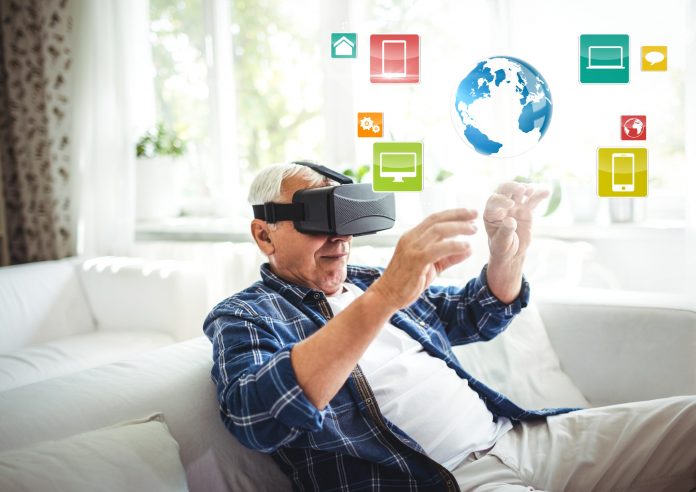While adopting a new technology isn’t the most straightforward feat, virtual reality (VR) makes the effort worthwhile.
For the uninitiated, VR is a 3D simulation that transports you into an interactive virtual space once you don a pair of glasses or a headset. Initially popularised in the video games industry, this technology is now injecting the same gamification principles into another burgeoning market: senior living. That’s right, VR is becoming a medium for older adults to socially engage and stay physically and mentally active.
Here are four ways virtual reality benefits individuals over 60:
Enhances Physical Activity
Immersing yourself in a VR fitness experience is some parts challenging for the body but all parts enjoyable. A study by Sage Journals reveals that VR-based physical training results in more strength, flexibility, agility, and cardiorespiratory fitness in older adults.
As seniors, it’s common to adopt a limited mindset about the body’s capabilities, often succumbing to the age-old belief that the body inevitably declines with time. While there’s some truth to this, the emergence of VR certainly changes the narrative. By infusing an interactive experience into your otherwise dull exercise routine, VR can take your fitness to another level (and it won’t have to feel like a chore).
Some must-try fitness VR games that can add a dash of excitement to your fitness journey include Beat Saber, FitXR, and The Climb 2. Beat Saber is a rhythm game in which players slice cubes with lightsabers to the beat of the music, while FitXR is a virtual fitness club offering dance, HIIT, and box workouts. And the Climb 2’s moderately difficult rock and skyscraper climbing works your upper body muscles effectively.
Keeps the Mind Sharp
The mind is akin to a machine, and like any top-functioning machine, keeping it smoothly working requires some work on your part, especially in your golden years. According to research, virtual reality keeps your cognitive wheel spinning by strengthening neural connectors needed for memory retention and attentional control. In other words, it rewires your brain to function at its optimal health. This positive impact is seen in a University of Maryland study that reports enhanced memory accuracy of up to 8.8% while using VR.
Emerging scientific research even promises that VR exergaming (video games involving physical movement) prevents memory loss in seniors with Alzheimer’s and Parkinson’s, and neurological issues such as multiple sclerosis. However, Ryan Glatt, board-certified health coach at Pacific Brain Health Center tells CNET, “This (VR gaming) isn’t a magic pill. Many people might feel immediate improvements, but to retain the benefits we need repeated exposure, just like with regular exercise.”
RendeverFit, a standout VR platform, lets you choose between three core modules: cycling, paddling, and painting. It also combines social, physical, and cognitive modes and showcases your growth trajectory through metrics for added motivation. Beyond games, the platform has plenty of live sessions conducted by hosts, including Move and Groove, book clubs, mindfulness practices, and more.
Bridges the Gap Between the Present Reality and Unfulfilled Desires
Older adults ‘now’ may be far removed from their desires. This discrepancy can stem from various factors, such as health issues, social isolation, limited mobility, or lack of access to fulfilling activities.
However, VR can transport you across the globe, or even to Mars. And if it’s a crazy, hollering rollercoaster ride you’re after, who says you can’t hop into a virtual cart? For instance, the Grand Canyon VR experience by Immersive Entertainment invites voyagers to cruise along the Grand Canyon. Depending on your mood, you can opt for a daylight or moonlit view, feed fish as you steer your kayak, or halt and soak in the scenery.
Everest VR by Solfar Studios is a beginner-friendly adventure with five scenic pit stops and detailed narratives, culminating at Mount Everest’s Summit. Those with an art inclination and a thirst for knowledge won’t want to miss experiencing The VR Museum of Fine Art from Finn Sinclair. With each painting’s brushstroke popping out and a 360-degree view of Michelangelo’s David, its attention to detail is out-of-this-world.
Through immersive digital experiences like VR, what once seemed out of reach can now become your lived reality.
Reduces Feelings of Loneliness
Loneliness and social isolation are realities we cannot overlook among the senior population. Throw into the mix physical limitations and deteriorating health, and this conundrum exacerbates. If you’re seeking some respite during these trying times (and beyond), you’ll want to integrate VR into your lives.
Virtual reality opens the digital sphere, teleporting you into a parallel reality that boosts community interaction, captivating discourses, and kinetic activities. This facilitates meaningful discussions and creates a sense of community among like-minded individuals.
Although studies are still limited on the use of VR in combatting loneliness, researchers are steadily gaining interest in it. In a study by Nature, 74 participants were asked to complete questionnaires measuring loneliness in offline (real-world) and online (VR) scenarios. Results indicated that participants generally felt less lonely and socially anxious in a VR environment compared to real-world settings. Additionally, those who were part of a virtual support group (VSG) reported even lower levels of loneliness and social anxiety.
Virtual reality applications like Alcove VR, Meta Quest 2, and Engage VR provide immersive environments where older adults can connect, engage in various activities, and share experiences.

VR Is Changing the Game for Seniors
VR does everything from combating loneliness and keeping the mind and body in good shape to transporting you to far-flung places. Sure, there is a slight learning curve to this technology, but with a little bit of perseverance, you can immerse yourself in a vast array of applications brimming with virtual yet authentic experiences.



